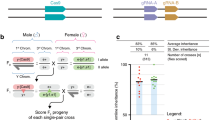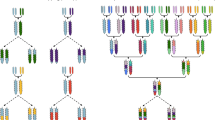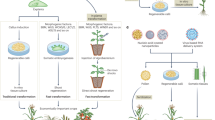Abstract
The potential of genetically modified (GM) crops to transfer foreign genes through pollen to related plant species has been cited as an environmental concern. Until more is known concerning the environmental impact of novel genes on indigenous crops and weeds, practical and regulatory considerations will likely require the adoption of gene-containment approaches for future generations of GM crops. Most molecular approaches with potential for controlling gene flow among crops and weeds have thus far focused on maternal inheritance, male sterility, and seed sterility. Several other containment strategies may also prove useful in restricting gene flow, including apomixis (vegetative propagation and asexual seed formation), cleistogamy (self-fertilization without opening of the flower), genome incompatibility, chemical induction/deletion of transgenes, fruit-specific excision of transgenes, and transgenic mitigation (transgenes that compromise fitness in the hybrid). As yet, however, no strategy has proved broadly applicable to all crop species, and a combination of approaches may prove most effective for engineering the next generation of GM crops.
This is a preview of subscription content, access via your institution
Access options
Subscribe to this journal
Receive 12 print issues and online access
$209.00 per year
only $17.42 per issue
Buy this article
- Purchase on Springer Link
- Instant access to full article PDF
Prices may be subject to local taxes which are calculated during checkout

Similar content being viewed by others
References
Hurst, L.D. Cytoplasmic genetics under inbreeding and outbreeding. Proc. Royal Soc. London B 258, 287–298 (1994).
Gressel, J. Molecular Biology in Weed Control (Taylor and Francis, London, 2002).
Vielle-Calzada, J.P., Baskar, R. & Grossniklaus, U. Delayed activation of the paternal genome during seed development. Nature 404, 91–94 (2000).
Avni, A. & Edelman, M. Direct selection for paternal inheritance of chloroplasts in sexual progeny of Nicotiana. Mol. Gen. Genet. 225, 273–277 (1991).
Corriveau, J.P. & Coleman, A.W. Rapid screening method to detect potential biparental inheritance of plastid DNA and results for over 200 angiosperm species. Am. J. Botany 75, 1443–1458 (1988).
Tilney-Bassett, R.A.E. & Abdel-Wahab, O.A.L. Maternal effects and plastid inheritance, in Maternal Effects in Development (eds Newth, D. R. & Balls, M.) 29–45 (Cambridge University Press, Cambridge, 1979).
Hagemann, R. & Schroeder, M. The cytological basis of plastid inheritance in angiosperms. Protoplasma 152, 57–64 (1989).
Daniell, H., Datta, R., Varma, S., Gray, S. & Lee, S.B. Containment of herbicide resistance through genetic engineering of the chloroplast genome. Nat. Biotechnol. 16, 345–348 (1998).
Ruf, S., Hermann, M., Berger, I.J., Carrer, H. & Bock, R. Stable genetic transformation of tomato plastids—high-level foreign protein expression in fruits. Nat. Biotechnol. 19, 870–875 (2001).
Daniell, H., Khan, M.S. & Allison, L. Milestones in chloroplast genetic engineering: an environmentally friendly era in biotechnology. Trends Plant Sci. 7, 84–91 (2001).
Daniell, H. & Dhingra, A. Multiple gene engineering: dawn of an exiting new era in biotechnology. Curr. Opin. Biotechnol. 13, 136–141 (2002).
Scott, S.E. & Wilkinson, M.J. Risks of transgene escape from transplastomic oilseed rape. Nat. Biotechnol. 17, 390–392 (1999).
DeCosa, B., Moar, W., Lee, S.B., Miller, M. & Daniell, H. Overexpression of the Bt Cry2Aa2 operon in chloroplasts leads to formation of insecticidal crystals. Nat. Biotechnol. 19, 71–74 (2001).
Daniell, H., Muthukumar, B. & Lee, S.B. Engineering the chloroplast genome without the use of antibiotic selection. Curr. Genet. 39, 109–116 (2001).
Kota, M. et al. Overexpression of the Bacillus thuringiensis Cry2A protein in chloroplasts confers resistance to plants against susceptible and Bt-resistant insects. Proc. Natl. Acad. Sci. USA 96, 1940–1845 (1999).
DeGray, G., Smith, F., Sanford, J. & Daniell, H. Expression of an antimicrobial peptide via the chloroplast genome to control phytopathogenic bacteria. Plant Physiol. 127, 852–862 (2001).
Lee, S.B., Byun, M.O. & Daniell, H. Accumulation of trehalose within transgenic chloroplasts confers drought tolerance. Transgenic Res., in press (2002)
Daniell, H., Lee, S.B., Panchal, T. & Wiebe, P.O. Expression and assembly of the native cholera toxin B subunit gene as functional oligomers in transgenic tobacco chloroplasts. J. Mol. Biol. 311, 1001–1009 (2001).
Eastham, K. & Sweet, J. Genetically Modified Organisms (GMOs): The Significance of Gene Flow Through Pollen Transfer. Environmental Issue Report 28 (European Environmental Agency, Copenhagen, Denmark, 2002).
Mariani, C., DeBeuckeleer, M., Trueltner, J., Leemans, J. & Goldberg, R.B. Induction of male sterility in plants by a chimaeric ribonuclease gene. Nature 347, 737–741 (1990).
Hall, L.M. et al. Pollen flow between herbicide-resistant Brassica napus is the cause of multiple resistant B. napus volunteers. Weed Sci. 48, 688–694 (2000).
Odell, J.T. Site specific recombination in plant cells. WO 91/09957 (1991).
Odell, J.T., Hoopes, J.L. & Vermerris, W. Seed-specific gene activation mediated by the Cre/lox site-specific recombination system. Plant Physiol. 106, 447–458 (1994).
Russell, S.H., Hoopes, J.L. & Odell, J.T. Directed excision of a transgene from the plant genome. Mol. Gen. Genet. 234, 49–59 (1992).
Tomes, D.T. Genetic constructs and methods for producing fruits with very little or diminished seed. WO 97/40179 (1997).
Koivu, K., Kanerva, A. & Pehu, E. Molecular control of transgene escape from genetically modified plants. Plant Sci. 160, 517–522 (2001).
Koltunow, A.M., Bicknell, R.A. & Chaudhury, A.M. Apomixis: molecular strategies for the generation of genetically identical seeds without fertilization. Plant Physiol. 108, 1345–1352 (1995).
Jepson, I. Inducible herbicide resistance. WO 97/06269 (EPO 0843730) (1997)
Keenan, R.J. & Stemmer, W.P.C. Nontransgenic crops from transgenic plants. Nat. Biotechnol. 20, 215–216 (2002).
Gressel, J. Tandem constructs: preventing the rise of superweeds. Trends Biotechnol. 17, 361–366 (1999).
Steber, C.M., Cooney, S.E. & Mccourt, P. Isolation of the GA-response mutant sly1 as a suppressor of ABI1-1 in Arabidopsis thaliana. Genetics 149, 509–521 (1998).
Lilegren, S.J. et al. SHATTERPROOF MADS-box genes control seed dispersal in Arabidopsis. Nature 404, 766–770 (2000).
Webb, S.E., Appleford, N.E.J., Gaskin, P. & Lenton, J.R. Gibberellins in internodes and ears of wheat containing different dwarfing alleles. Phytochemistry 47, 671–677 (1998).
Peng, J. et al. “Green revolution” genes encode mutant gibberellin response modulators. Nature 400, 256 (1999).
Acknowledgements
The author is grateful to the editor of Nature Biotechnology, Andrew Marshall, for valuable contributions and thorough editing of this manuscript. The author also thanks Jonathan Gressel (Weizmann Institute of Science, Rehovot, Israel) for providing an advance copy of the material in the forthcoming book Molecular Biology in Weed Control, Jeremy Sweet (NIAB, Cambridge) for critical comments, and Chuck Niblett (University of Florida, Gainesville, FL) for editing the manuscript.
Author information
Authors and Affiliations
Corresponding author
Rights and permissions
About this article
Cite this article
Daniell, H. Molecular strategies for gene containment in transgenic crops. Nat Biotechnol 20, 581–586 (2002). https://doi.org/10.1038/nbt0602-581
Received:
Accepted:
Issue Date:
DOI: https://doi.org/10.1038/nbt0602-581
This article is cited by
-
Accumulation of mutations in the AP2 homoeologs causes suppression of anther extrusion with altered spike and culm development in hexaploid wheat
Molecular Breeding (2024)
-
Tobacco as green bioreactor for therapeutic protein production: latest breakthroughs and optimization strategies
Plant Growth Regulation (2023)
-
Overexpression of SHORT VEGETATIVE PHASE-LIKE (SVL) in Populus delays onset and reduces abundance of flowering in field-grown trees
Horticulture Research (2021)
-
Genetic dissection of QTLs associated with spikelet-related traits and grain size in sorghum
Scientific Reports (2021)
-
Construction of risk assessment manual for genetically modified rice (Oryza sativa L.)
Journal of Crop Science and Biotechnology (2021)



